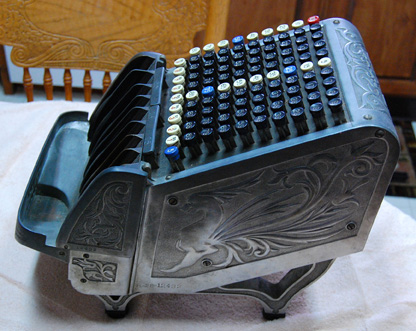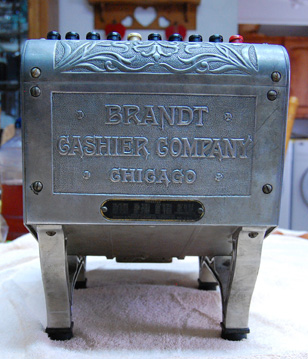 |
|
||||
 |
 |
||||
RINKER ON COLLECTIBLES — Column #1437 Copyright © Harry Rinker, LLC 2014
Questions
and Answers QUESTION: I have a coin changer that my mother bought in the 1960s from a store in center city Reading [PA] that was going out of business. This information is cast into the back: “BRANDT/ CASHIER COMPANY/CHICAGO.” A panel on the side has “R-28 12432.” The sides have an elaborate Art Deco motif. There are ten rows of keys on the top and nine coin chutes on the front. The machine measures 8 1/2 inches by 12 inches x 11 inches. I would like to know more about this coin changer. – LS, Reading, PA, Email
ANSWER: Edward J. Brandt and a group of investors founded Brandt Manufacturing, located in Watertown, Wisconsin, in the late 1800s. In 1907, the company split into two separate corporations—Brandt Cashier Manufacturing Company and Brandt-Dent Company, the latter a manufacturer of gas fixtures. The coin changer was designed to perform two functions. First, the pressing of a single key produced the exact change required. Second, the change would consist of the minimum number of coins possible. In 1921, the Brandt Cashier Manufacturing Company in Watertown had over 100 employees. The company had offices in Atlanta, Boston, Philadelphia, Pittsburgh, Minneapolis, New York, Washington, DC, and other locations. Brandt also had production facilities in Chicago. Brandt Manufacturing remained in family hands until January 1984. A succession of owners followed. These owners sold off various divisions. Today, the former Brandt Cashier Manufacturing Company (Brandt Automated Cashier Co.) is named Talaris, Inc., a division of the Carlyle Group. [See: http://www.watertownhistory.org/articles/BrandtManufacturing.htm for a more detailed history.] In the educated guess category, the “R28-12432” indicates the machine was made in 1928 and was the 12,432 machine manufactured that year. Given the popularity of the Brandt coin cashier, I doubt if the 12,432 is a running serial number beginning with the first machine made. Holabird-Kagin Americana of Reno, Nevada, sold an example of your “automatic cashier device” on eBay in 2013. The closing price was $150.00 plus $29.25 shipping. The machine with a serial number of “R62-15404” appears identical to the one you own. Assuming this machine was made in 1962, the outward appearance changed very little. There must have been some internal mechanical changes during the course of manufacturing that are not evident from the outside. There is only minimal American collector interest in business machines. The primary market for such devices is Europe, especially Germany. If you wish to sell your machine, contact Auction Team Breker. Lee Richmond at (703) 796-5544 is the firm’s American representative. The price realized on eBay was a strong one. Also consider this option.
Your Brandt coin changer will be bought as a conversation, not a collector item. The machine displays well. Its Art Deco shape and surface design motif defines it as a major piece of industrial age art. Given this, a value around $150.00 is reasonable. QUESTION: I own a lighter that I found in my attic many years ago. The base is a clear plastic block in which a fishing fly is encased. The lighter unit consists of a snap-type lighter at the top and a round base at the bottom. The round base fits into the plastic block. The lighter can be removed to refill the fuel. The screw that is removed to refuel reads: EVANS / FUEL.” The unit still works. What is its value? – TM, San Antonio, TX, Email Question ANSWER: By the mid-19th century, Attleboro, Massachusetts, was home to several manufacturers of buttons, jewelry and jewelry findings, and other specialized stamped and die-cut metal products. In 1807, Colonel Obed Robinson of Attleboro began manufacturing jewelry. During the War of 1812, the company switched its focus from jewelry to buttons, especially uniform buttons. In 1848, Daniel Evans purchased the company, known as R & W Robison by that time, and renamed it D. Evans & Co. The new company shifted its manufacturing to gift buttons. Daniel Evans was succeeded by his son Edwin. When Edwin died in 1913, the company was reorganized. A Novelty Division was created. Its products included picture frames and neck chains for US Navy dog tags. In 1918, Alfred Reilly became the superintendent of the Novelty Department. World War I ended in November 1918 and with it the end of government contracts. Reilly, working with Samuel Halsam, turned Evans’ attention to metal vanity cases. An order from United Drug Company for metal cases for its Jonteel line established the D. Evan Co. as a leading manufacturer of metal case products, such as cigarette cases, coin purses, compacts, and vanity cases. [See http://collectingvintagecompacts.blogspot.com/2012/05/evans-case-company-part-1-from-buttons.html for more information] In 1922, Evans began manufacturing lighters. Lighter types included Automatic, Banner, Clipper, Liftarm, Petite, Rollerbearing, Supreme, Trig-A-Lite, and Tube. Ronson claimed the Evans’ Trig-A-Lite, a one press system, copied their lighting system. A lawsuit followed. Evans settled with Ronson. [See: http://www.elegantlighters.com/category-s/1836.htm] Evans produced many lighters with enamel and plastic bases. Some of the enamel bases were in the shape of fruit. Evans continued to manufacture lighters until the late 1960s or early 1970s. I found several examples of Evans lighters with plastic bases with various items encased in the plastic. See the “Evans Table Lighters” URL on http://www.vintage-evans-and-classic-cigarette-lighters.com/. Page 5 of this URL contains examples of plastic cylinder shape bodies with an animal or bird insert. Evans lighters with a plastic base featuring an encased insert appear regularly for sale on eBay. Currently, eBay has over 500 listings for Evans lighters. An example of a plastic base lighter featuring a cow currently is listed at $9.99. Because your Evans lighter has crossover value for the fishing collector and is in working condition, its value is between $15.00 and $20.00. QUESTION: I have a World War II purple heart that was awarded to a member of my family. I would like to sell it. Is there a law that prohibits the sale of this medal? If not, what is its value and where can I obtain the best price? – M, Bower, PA ANSWER: The United States military has granted over 17 million purple hearts. The website http://www.americanwarlibrary.com/theheart.htm contains detailed information about the myths surrounding the Purple Heart. In June 2012, a Supreme Court decision overturned a seven-year law that prohibited the buying and selling of Purple Hearts. Although the Supreme Court ruled in favor of collectors, the issue remains highly controversial within the military and military collecting communities. The issue became even more heated when the Supreme Court struck down the 2006 Stolen Valor Act designed to punish those who falsely claim to have received military honors. [See: http://usnews.nbcnews.com/_news/2012/09/18/13931135-medal-peddlers-thriving-purple-heart-market-has-fans-and-foes?lite for more detailed information.} Most of the Purple Heart and other military medals in the secondary market are sold at auctions, estate sales, and garage sales, often without any effort of an estate executor or heir to contact family members who might wish to keep them in the family. The website Purple Hearts Reunited (http://purpleheartsreunited.org/) locates lost or stolen military medals and attempts to return them to the family heirs of the original recipients. The value of a Purple Heart medal ranges from the low to middle hundreds of dollars. Medals associated with a specific individual, especially if killed in action, date of issue, engraved information on the reverse, and supporting paper documentation are factors the lead to increased value. The website http://www.baystatemilitaria.com/ is a quick source for asking price information for military medals such as the Purple Heart. In conclusion, I want to encourage you to keep your Purple Heart medal in the family. If no one on your side of the family has an interest, contact your nieces and nephews. If you must sell it because you need funds, offer it to them first. If this fails, you will have little trouble finding a buyer at a local firearms show and sale. There are several in the greater Reading area. QUESTION: I have a 1919 British West Africa one penny coin. The round has a round hole in the center. The front of the coin features a Star of David. What can you tell me about it? – D, Navasota, TX ANSWER: The United Kingdom had a number of colonies located on the west coast of Africa during its colonial period. All were administered under the collective name of British West Africa. The primary purpose of these colonies was to aid the British Royal Navy’s West Africa Squadron. British West Africa included the British Gold Coast (Ghana), Gambia, eastern, northern, and western Nigeria, and Sierra Leone. From 1907 to 1958, 1/10 (one tenth), 1/2 (one half), and 1 penny coins were issued. All three denominations were holed, had a six-sided (hexagram) star, a crown, and the name of the British monarch. A variety of metals—aluminum, copper-nickel, and bronze—were used. The website http://coinquest.com/cgi-bin/cq/coins?main_coin=10597 values the common 1919 British West Africa one penny coin at $1.00 in worn condition, $2.00 in average circulated condition, $3.00 in well preserved condition, and $8.00 in uncirculated condition. The 1919 British West Africa one penny came in a KN (copper nickel) mint mark. This variation has a value between $30.00 and 50.00.Harry L. Rinker welcomes questions from readers about
collectibles, those mass-produced items from the twentieth and twenty-first centuries.
Selected letters will be answered in this column.
Harry cannot provide personal answers.
Photos and other material submitted cannot be
returned.
Send your questions to: Rinker on Collectibles, 5955 Mill
Point Court SE, Kentwood, MI 49512.
You also can e-mail your questions to
harrylrinker@aol.com.
Only e-mails containing a full name and mailing address
will be considered.
You can listen
and participate in
WHATCHA GOT?, Harry’s
antiques and collectibles radio call-in show, on Sunday mornings between 8:00 AM
and 10:00 AM Eastern Time.
If you
cannot find it on a station in your area,
WHATCHA GOT?
streams live on the Internet at www.gcnlive.com.
SELL, KEEP OR TOSS?: HOW TO DOWNSIZE A HOME,
SETTLE AN ESTATE, AND APPRAISE PERSONAL PROPERTY
(House of Collectibles, an imprint of Random House Information Group, $17.99),
Harry’s latest book, is available at your favorite bookstore and via
www.harryrinker.com.
|
|||||

